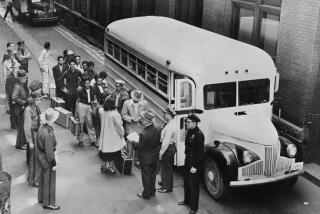Serra Statue to Be Shown Over Protests of 2 Groups
- Share via
Despite objections from a city art committee and an American Indian group, the Ventura City Council has decided to display a wooden statue of Father Junipero Serra, at least temporarily, in the new City Hall atrium.
Indian leaders objected to the likeness of Serra, who some view as more oppressor than apostle, being placed near two replicas of Chumash rock-paintings planned for the space. The art committee felt that the atrium was too small for proper display of the 9-foot, 4-inch statue.
Still, council members said they felt an obligation to the local craftsmen who spent 16 months carving the piece, which is the model for a bronze statue that will replace the crumbling Serra monument outside City Hall and has been lying in a downtown workshop since August awaiting a home.
“The carving is not only a work of art, but a work of love,” said City Councilwoman Nan Drake, whose motion Monday to accept the wooden statue until “a more suitable place is found” received unanimous support.
Not Suited for Size of Atrium
But the City Hall Art Selection Committee, a council-appointed group that selected the Chumash murals, says the statue of the Spanish missionary is “not harmonious” with the design of the refurbished atrium.
“It’s way too large for the area,” said Cynthia Lloyd-Butler, one of the committee’s six members. “It just doesn’t work. It would look stupid . . . like a misfit.”
The Candelaria American Indian Council, an Oxnard-based social service organization, found more than aesthetic problems in having to share the space.
“What a slap in the face to the Indian people,” said Jessica M. Roybal, executive director of the group. “I’m heartbroken. . . . The City Council is being totally insensitive.”
Council members, however, hoped that their action would cap an emotional debate over the fate of the statue, a project begun in 1986 by then-Councilman Russ Burns to replace the decomposing sand and gravel figure built by Meiners Oaks sculptor John Palo-Kangas 51 years ago.
Art Committee Not Consulted
Although council members and volunteer carvers had long assumed that the wooden version would ultimately be housed in the atrium, the council neglected to share those expectations with the City Hall Art Selection Committee, which chose the Chumash paintings in June.
In fact, it was not until Aug. 2, the day before the wooden piece was scheduled to be moved to the atrium, that the art committee learned of the plan and put on the brakes.
“We felt very much rebuffed,” said Wilbur Rubottom, the retired Ventura cabinetmaker who led the carving team. “We felt like a bride left standing at the altar.”
At Monday’s meeting, Rubottom and Burns complained that the council apparently thought that the statue was “worth nothing at this point,” and they requested that a home be found for “one of the finest pieces of artwork” ever done in Ventura.
“I feel very, very badly about this,” said Drake, who had recommended forming the art selection committee. “I don’t think anyone meant in any way to make one piece of art lesser or greater than another.”
Rubottom said the wooden statue, which requires a 50-foot crane to be moved, could be in the atrium by next week. The bronze cast, which is being prepared by students at the College of the Desert in Palm Desert, is expected to be ready early in 1989.
Meanwhile, the Chumash petroglyphs, which are being painted by Kathleen Conti, an artist and museum educator at the Santa Barbara County Museum of Natural History, are expected to be unveiled early next year.
Conti, who said she consulted three Chumash elders about the appropriateness of placing the sacred murals in City Hall before beginning the project, declined to speculate about their reaction should the paintings end up as a backdrop for the Serra statue.
But Roybal, who had written to the City Council two weeks ago expressing her opposition to the statue being placed there, was quick to react.
“I hope they don’t put the Chumash paintings in there now,” she said. “It seems like they don’t give a damn about the Chumash.”
More to Read
Sign up for Essential California
The most important California stories and recommendations in your inbox every morning.
You may occasionally receive promotional content from the Los Angeles Times.













